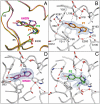Crystallographic snapshots of the complete reaction cycle of nicotine degradation by an amine oxidase of the monoamine oxidase (MAO) family
- PMID: 21383134
- PMCID: PMC3064382
- DOI: 10.1073/pnas.1016684108
Crystallographic snapshots of the complete reaction cycle of nicotine degradation by an amine oxidase of the monoamine oxidase (MAO) family
Abstract
FAD-linked oxidases constitute a class of enzymes which catalyze dehydrogenation as a fundamental biochemical reaction, followed by reoxidation of reduced flavin. Here, we present high-resolution crystal structures showing the flavoenzyme 6-hydroxy-l-nicotine oxidase in action. This enzyme was trapped during catalytic degradation of the native substrate in a sequence of discrete reaction states corresponding to the substrate-reduced enzyme, a complex of the enzyme with the intermediate enamine product and formation of the final aminoketone product. The inactive d-stereoisomer binds in mirror symmetry with respect to the catalytic axis, revealing absolute stereospecificity of hydrogen transfer to the flavin. The structural data suggest deprotonation of the substrate when bound at the active site, an overall binary complex mechanism and oxidation by direct hydride transfer. The amine nitrogen has a critical role in the dehydrogenation step and may activate carbocation formation at the α-carbon via delocalization from the lone pair to σ* C(α)-H. Enzymatically assisted hydrolysis of the intermediate product occurs at a remote (P site) cavity. Substrate entry and product exit follow different paths. Structural and kinetic data suggest that substrate can also bind to the reduced enzyme, associated with slower reoxidation as compared to the rate of reoxidation of free enzyme. The results are of general relevance for the mechanisms of flavin amine oxidases.
Conflict of interest statement
The authors declare no conflict of interest.
Figures




References
-
- Binda C, Newton-Vinson P, Hubálek F, Edmondson DE, Mattevi A. Structure of human monoamine oxidase B, a drug target for the treatment of neurological disorders. Nat Struct Biol. 2002;9:22–26. - PubMed
-
- Ghisla S, Massey V. Mechanisms of flavoprotein-catalyzed reactions. Eur J Biochem. 1989;181(1):1–17. - PubMed
-
- Scrutton NS. Chemical aspects of amine oxidation by flavoprotein enzymes. Nat Prod Rep. 2004;21:722–730. - PubMed
-
- Fitzpatrick PF. Carbanion versus hydride transfer mechanisms in flavoprotein-catalyzed dehydrogenations. Bioorg Chem. 2004;32:125–139. - PubMed
MeSH terms
Substances
Associated data
- Actions
- Actions
- Actions
- Actions
- Actions
- Actions
- Actions
- Actions
LinkOut - more resources
Full Text Sources

